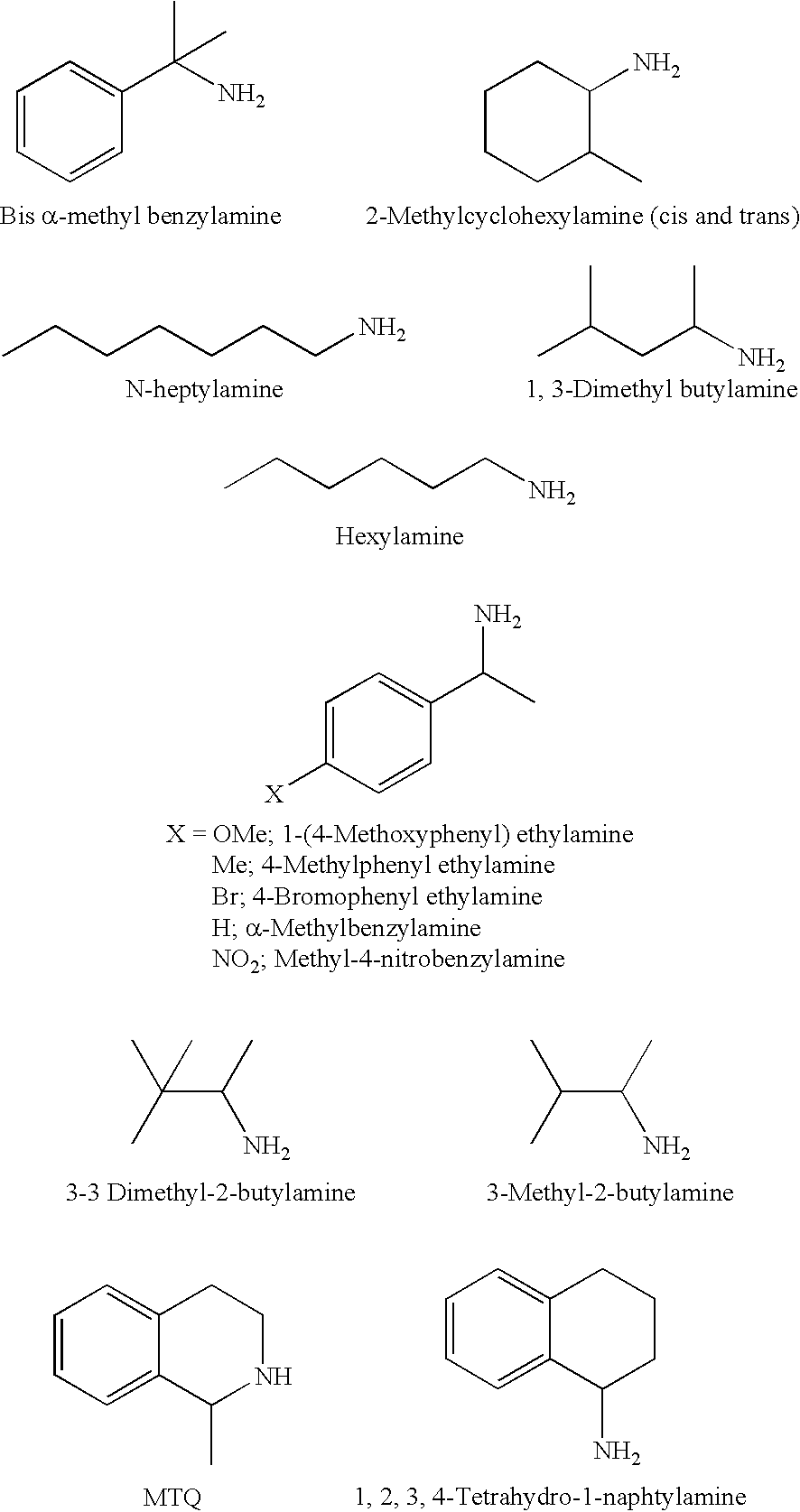Deracemisation of amines
a technology of amines and amines, which is applied in the field of deracemisation of amines, can solve the problems of no-one to date having successfully applied a deracemisation method to amines, and achieve the effects of improving enzyme production, easy visualisation, and changing enzyme activity
- Summary
- Abstract
- Description
- Claims
- Application Information
AI Technical Summary
Benefits of technology
Problems solved by technology
Method used
Image
Examples
example 2
Screening for MAO Mutants
[0043] The plate assay method (FIG. 2) was used to identify MAO mutants with activity towards L-AMBA. More specifically, E. coli BL21(DE3) transformants (2500 colonies per plate) were plated on HiBond-C Extra (Amersham Pharmacia) membrane placed on an LB Amp agar plates and incubated for 24 h at 37° C. Membranes containing the colonies were pulled from the plates, kept at −20° C. for 24 h and incubated with assay mixture at room temperature for 24 h.
Assay Mixture:
[0044] 1 tablet of DAB (3,3′-diaminobenzidine, Sigma, D4418) [0045] 1 ml of K phosphate buffer (1M, pH7.6) [0046] 30 μl L-AMBA (10 mM) [0047] 30 μl horseradish peroxidase (Sigma) 1 mg / ml [0048] 10 ml 2% agarose (Bio-Rad) [0049] Water up to 20 ml
[0050] Positive clones were subjected to a second round of screening (100-200 colonies per plate) to confirm activity.
example 3
Activity Studies
a) Clone Selection
[0051] 27 positive clones identified in the plate assay as having improved activity towards L-AMBA compared to the wild-type enzyme were grown on a small scale and assayed against both L- and D-AMBA. 10 ml LB Amp was inoculated with a single colony of E. coli BL21 (DE3) transformed with the protein expression vector pET16b harbouring the gene of interest and cultured in a 50 ml Falcon tube with agitation for 24 h. At the end of incubation 1 ml of cell culture was centrifuged, the pellet was resuspended in 1 ml of 25 mM potassium phosphate buffer pH7.6 and 0.1 ml was used to perform a hydrogen peroxide formation assay using both L- and D-AMBA as substrates.
Assay mixture: (Manfred Braun et al, Applied Microbiology and Biotechnology (1992) 37:594-598)
[0052] 5 ml phosphate buffer (1M, pH7.6) [0053] 500 μl 2,4,6-tribromohydrobenzoic acid (2% in DMSO), [0054] 37.5 μl 4-aminoantipurine (1M) [0055] 32.5 μL or D-AMBA (final concn 5 mM) [0056] Water up ...
example 4
Deracemisation Reaction
[0083] Using DL-AMBA as the substrate, in the presence of the mutant MAO-N, a range of reducing agents were screened (sodium borohydride, catalytic transfer hydrogenation, amine:boranes). This screen identified ammonia:borane as the optimal reagent which gave a 77% yield of D-AMBA with an enantiomeric excess=93%. Greater optical purities of the product (up to 99% e.e.) could be achieved although at the expense of yield.
[0084] More specifically, MAO mutant N336S (100 μl of 0.193 U.ml−1=0.02 U) was added to a solution of DL-AMBA (0.13 μl, final concentration=0.8 mM) and ammonia-borane complex (10 μl of 4M solution, final concentration=80 mM, 100 eq) in phosphate buffer (400 μl, 20 mM, pH8). A 10 μl aliquot was diluted in 990 μl perchloric acid, pH 1.5 and analysed by HPLC. The reaction mixture was incubated at 30° C. and the reaction monitored by HPLC at regular intervals until no further reaction was observed.
[0085] Yield: D-AMBA=77%, e.e.=93%
Analytical Co...
PUM
| Property | Measurement | Unit |
|---|---|---|
| Mass | aaaaa | aaaaa |
| Mass | aaaaa | aaaaa |
| Mass | aaaaa | aaaaa |
Abstract
Description
Claims
Application Information
 Login to View More
Login to View More - R&D
- Intellectual Property
- Life Sciences
- Materials
- Tech Scout
- Unparalleled Data Quality
- Higher Quality Content
- 60% Fewer Hallucinations
Browse by: Latest US Patents, China's latest patents, Technical Efficacy Thesaurus, Application Domain, Technology Topic, Popular Technical Reports.
© 2025 PatSnap. All rights reserved.Legal|Privacy policy|Modern Slavery Act Transparency Statement|Sitemap|About US| Contact US: help@patsnap.com



